Cities, like living things, evolve slowly over time. Buildings and structures get added and renovated and removed, and in this process, bits and pieces that get left behind. Vestiges. Just as humans have tailbones and whales have pelvic bones, cities have doors that open into a limb-breaking drop, segments of fences that anyone can walk around, and pipes that carry nothing at all.
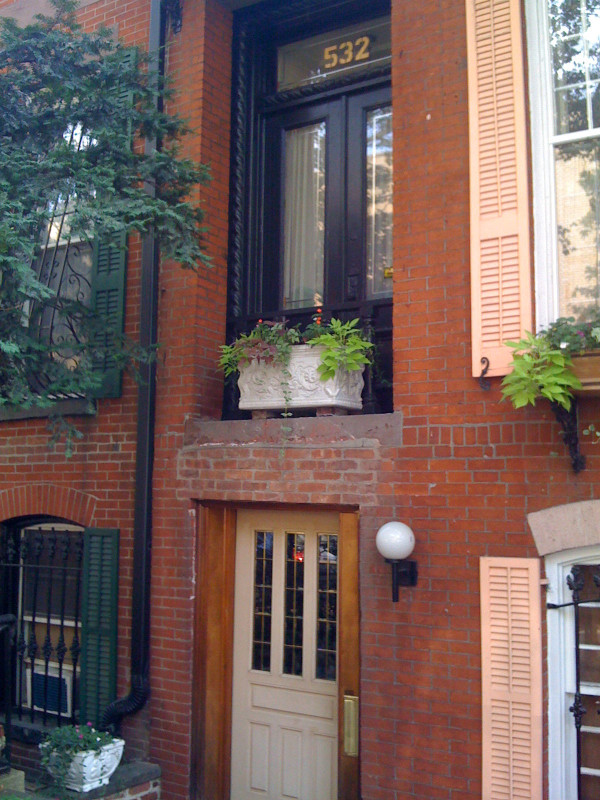
Most of the time, these architectural leftovers rust or crumble or get taken down. But other times, these vestiges aren’t removed. They remain in the urban organism. And sometimes — even though they no longer serve any discernible purpose — they’re actually maintained. They get cleaned and polished and re-painted just because they’re there.
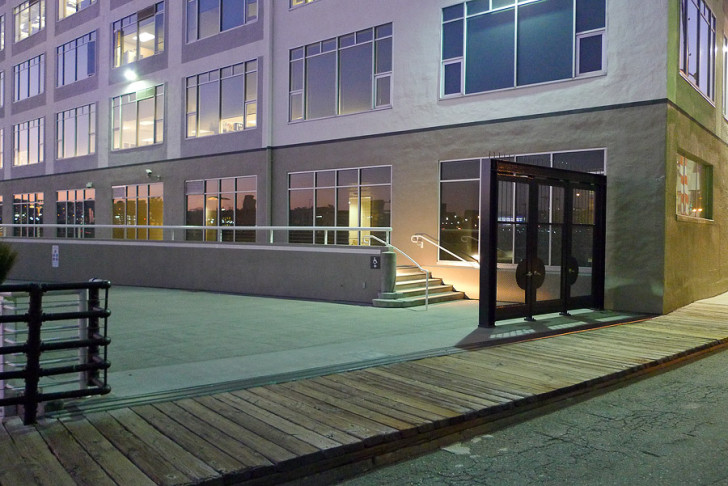
These urban vestiges first caught the attention of an artist in Japan named Akasegawa Genpei. One day, in 1972, he was walking to lunch, and he came across a staircase that went up and then back down but had no door at the top. Then Akasegawa noticed that a piece of the railing that had been recently fixed. That’s when something clicked.
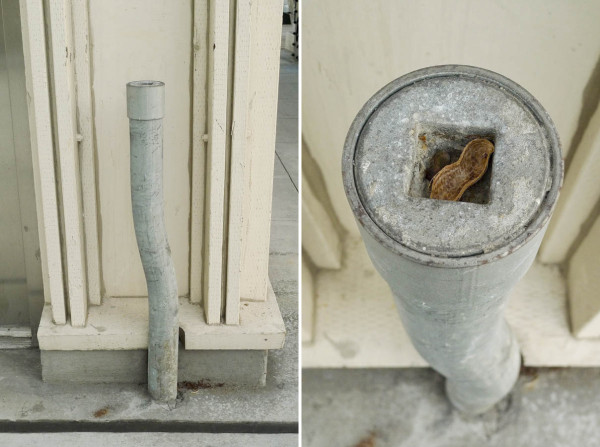
Akasegawa started noticing similar urban leftovers, and treasured them as artistic byproducts of the city. He photographed all the things he could find that were both vestigial and maintained. He began publishing his findings in a magazine column, accompanied by musings about each object.
People began to send Akasegawa pictures of similar architectural leftovers that they found, and in his column, Akasegawa would judge all submissions on two criteria:
- Were they truly, completely useless?
- Were they regularly maintained?
In 1985 Akasegawa published a book of these collected photographs and writings, in which he coined a term for these kinds of urban leftovers. He called them, “Thomassons.”

The term comes from Gary Thomasson, an American baseball player who was traded to the Yomiuri Giants, a team in Tokyo, Japan. Thomasson was paid exorbitant amount of money for a two year contract.
But in this new country, on this new team, the great slugger Gary Thomasson lost his game. He actually set the all-time strikeout record in Japan in 1981, and was benched for much of his contract.
For Akasegawa, Gary Thomasson was “useless” and also “maintained.”

Through Akasegawa’s writings, the term “Thomasson” spread. The science fiction writer William Gibson used it in to describe a dystopian, cyberpunk San Francisco.
“‘I don’t care,’ Yamasaki said, in English, San Francisco his witness. The whole city was a Thomasson. Perhaps America itself was a Thomasson.”— Virtual Light (p. 352), by William Gibson
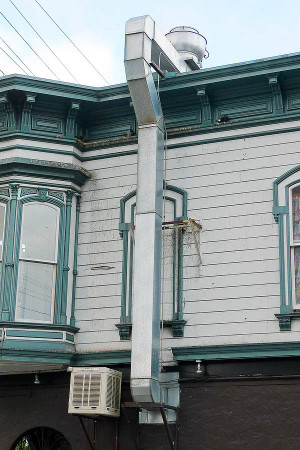
In 2009, Akasegawa’s book HyperArt Thomasson was published in English translation. The American publishers wanted to get a conversation going stateside. They set up a blog where people could offer up their own potential Thomassons for analysis and debate, much like Akasegawa’s original column. People sent in their Thomassons from around the world. (NB: the blog is now defunct, but continues in a different form here.)
Gary Thomasson and his family declined to comment for this story, and that’s understandable, given that the appropriation of his surname in this way does seem rather mean-spirited.

One could argue, though, that Akasegawa’s appropriation of the name “Thomasson” is a positive thing: Thomasson now joins the ranks of Cardigan, Léotard, Kelvin, Nobel, and Plimsoll — those who live on as eponyms.
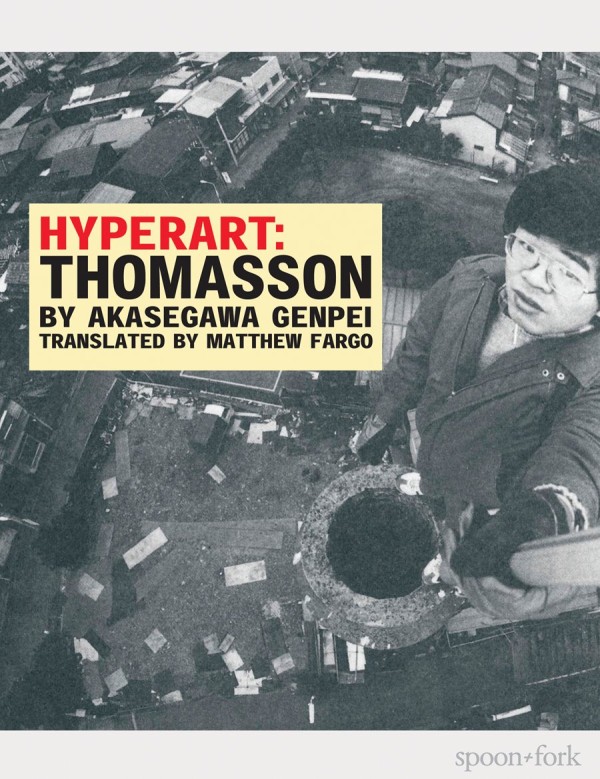



Comments (27)
Share
Thanks so much for this terrific piece! I would like to mention here, though: Seng Chen, who led the group of photographers who photographed SF Thomassons and who found most of the Thomassons used in the tour; Kearny Street Workshop (kearnystreet.org), the organization that commissioned the Thomassons tour; and Kaya Press, the publisher that commissioned and published the English translation of “Hyperart: Thomassons.” Allan, Seng, and I were working under their aegis.
Perhaps the ultimate Thomasson, since it is in a Major League ballpark is the ladder on the Green Monster at Fenway. It’s original purpose was to allow grounds crew to get to the top of the wall and retrieve balls from the netting that would catch home runs. Now that they have built seats atop the monster, there is no need for the ladder. Yet it remains there, hanging off the wall, occasionally causing a fly ball to take a completely unexpected ricochet to the outfielders dismay.
So, occasionally you’ll find cities where people have lived for decades or longer. And occasionally, over time, those people may have expanded their city, or made improvements or changes to it. And occasionally, through the course of these changes, workarounds are needed. Why is this interesting? Or even surprising?
In the real world, workarounds happen. Retrofits happen. Sometimes the problem is the cost of tearing everything out and starting fresh. Maybe the problem is the disruption it might cause. Maybe it’s just poor planning, or poor execution. The point is, it happens, think of it as design on the fly.
Lets talk about your specific example of the obsolete gate motor box standing next to it’s replacement. For the record, I don’t know anything concrete about this specific box, or these boxes in general, but here’s a few potential scenarios (off the top of my head) that could explain it’s presence:
Maybe it’s serving as a junction box for the electrical infrastructure that used to supply the old gate, and now supplies the new gate. Maybe the contractor that installed the new gates went out there with the intention of setting the new gate in the position of the old one, then discovered that the support structure under the old box was insufficient to safely support the new box. Maybe it was corroded a bit since for decades there had been a heavy iron box that contained a motor that frequently moved a heavy gate sitting on top of it. So maybe, in the interest of safety, the decision was made to relocate the new gates 4 feet to left.
But they’re still going to need power, so what to do?
A. Remove the old box. Which means moving the old electrical junction under it 4 feet also. Which probably means installing an industrial grade manhole style access box in sidewalk to facilitate the electrical renovation. Which in turn probably means some sidewalk removal and replacement. All of which will require restricting access to the area while the work is performed. Once all that’s done, there’s a pretty good chance electrical service to the bridge or immediate surrounding area would need to be interrupted for a time so the renovation could be performed. It probably also means a few more contractors in the mix since I’d be willing to bet the contractor that replaces the gates knows how to attach them to a power supply, but probably isn’t terribly interested in making renovations to the electrical supply itself. It stands to reason he’s probably not in the business of sidewalk installation either. None of which was planned for in the budget approved by the city architect and funded by the city taxpayers.
B. Leave the old box in place, install the new gate, install a 4 foot power extension, make up the connection. Come in on time, on budget, and safely, despite the obstacles.
Tough call. As a side note, scenario A takes the traffic controlling gate out of service for days at a minimum, which would likely make it necessary to bring in some police officers to direct traffic. Whereas in scenario B, the traffic controlling gate is only out of service for the few minuets it takes to disconnect power from the old one and turn on power to the new one.
As for the old box being “maintained”, again, the painting was probably done by a contractor that was probably hired to paint ‘the bridge equipment’. And if the rust on the bottom of the door shown in the picture on the website is any indication, that painting contractor hasn’t been out in a while.
Not every situation is purpose built. You guys can, and should, do better.
It is not hard to imagine how various thomassons came to be, as you illustrated, but that isn’t the point. Or perhaps, it’s part of their beauty. Being able to see history having been lived through building modifications is interesting. When these artifacts then become kept up and thus an intentional seeming part of the structure whose old meaning is usually obvious, but is no mothing more than decoration. Its pretty and odd. It isn’t about wondering how it could have come to be, its not that it is an unexplainable mystery, its just an aesthetically enjoyable phenomenon.
The effort to explain why the thomasson name is not mean is hollow. Nice people do mean things. This is such an occasion, it would seem. The choice to double down on the mean spirited name in the english publication is telling. We fans all bad-mouth our players in a slump but we don’t create lasting tributes to those brief frustrations.
Here in Toronto we did the ultimate expression of this. We tore down a elevated road that many people hated and then made a memorial for it out of it’s old pilings. I didn’t take this photo, but I think it needs to be here.
http://upload.wikimedia.org/wikipedia/commons/7/77/Scarborough_Expressway.jpg
That said, it seems that many of the “facade” preservation efforts are part of this. The outside of a building left just for decoration of the new condo or office tower seen to qualify.
I think that using the Thomsson name in this case isn’t the same meaning for japanese culture as it is in the west. There is a great appreciation for elders in japanese culture. To be so great during your life that even if things go wrong when you get old and you are still cared for is an honour. I can only hope my children feel the same for me. I’m happy that there is a place where being called “old lady” might be a complement.
In 1930’s Perth, Western Australia, we built an art deco tower that was intended to be used as a sewage gas vent.
It was a disaster, as the foul smelling gas just sank down to the suburbs below. They stopped using it almost immediately, but never demolished it. I think probably just because it’s kind of beautiful.
My photo: https://flic.kr/p/mXCKcU
Technically it is being used to mount a tiny little antenna, but I think it is maintained and I think is a Thomasson in spirit.
http://en.wikipedia.org/wiki/Lincoln_Street_Ventilation_Stack
I always find abandoned bridge pilings fascinating for what they were and the ties to history. e.g the Aqueduct Bridge in Georgetown, DC: http://www.washingtonpost.com/local/the-potomac-aqueduct-once-took-canal-boats-across-the-river/2013/12/07/68b2686e-5b82-11e3-a49b-90a0e156254b_story.html or the Machester Bridge in Pittsburgh, PA (now used to frame a statue of Mr. Rogers): http://en.wikipedia.org/wiki/Manchester_Bridge_(Pittsburgh)
The name thing went a bit long… You can tell the 99% crew loved the idea, but needed a work around for the 30+ year old snarky joke. It seemed overly apologetic. Telling ALL OF US we’ve made bad life choices because we haven’t listened The Postal Service… that was fine to do, right? Ep. 118, funny, funny, right? But let’s tip toe around one jock and his family.
As a fan of sports and design, I find the arguments supporting the names of the Washington Redskins and the Thomasson very similar. I think I heard that the name has been around for a long time, it is the perfect fit, and it is now some kind of honor. All of the arguments exclude the opinion of the offended party. In this case, the Thomasson middle finger photo has made that opinion very clear. These design oddities will exist no matter what the name is. The joy is in discovering them, and that will remain. So if there is an opportunity to change the name and eliminate the offensiveness, no matter how well meaning the name choice was, why not do it? After all, isn’t good design choice all about making the world incrementally better, even in some small way?
If a power socket has been painted shut, does it count as a thomasson? It now serves no purpose *because* it has been (lazily) maintained.
At the risk of sounding like a hair-splitting baseball nerd, I think it should be noted that, using any just about any baseball metric, Gary Thomasson could never be considered a great or “remarkable” major leaguer. A useful reserve outfielder for 8 or 9 years? Yes. Great major league players simply do not end their careers in Japan.
Otherwise, great piece!
Here in Belgium we Thomassons are combined with actual ‘intention’ :) https://www.facebook.com/Belgiansolutions?fref=nf
Are pearls Thomassons? The alternative is more abrasive than just integrating the ill-fitting element. A nicer name for the phenomenon might be “human pearls.”
demo costs money
I work in software development. Listening to this podcast it hits me, we do this all the time with software. When making general purpose software for other programmers we really don’t know all that will be needed or used. So we build different ways of calling bits of the code. The other programmer will then use the way that is most useful to their software. It’s very likely some of the code we build will never be called, even if the software is used by lots of other programmers. However when new features are added or bugs fixed we will re-visit all the code and make maintenance changes as needed. So in a way this unused code is Thomasson in concept, it’s created and maintained but never used. I guess you could argue that it is not Tomasson because it could be used where a stairway that goes nowhere isn’t useful other than to see from a different height. At a minimum it has me thinking.
Roman, what a great piece to listen while I drove from the San Jose Adobe HQ up to the Walnut Creek area. The traffic was mindbendingly awful, your story was tingly, lovely and quite brillig.
Would the iconic Western Auto sign in Kansas City qualify? https://www.flickr.com/photos/rock_chalk_jhawk_ku/5693750140
I listened to this when I was on a train from Vancouver, BC. Oddly, at Pacific Central Station I spotted a Thomasson, without – at that time – knowing what it really was!
See this old photo of the station:
http://photos.wikimapia.org/p/00/03/21/32/03_big.jpg
Notice the four phone booths to the left. Now look at this newer photo:
http://www.photographybylyon.com/Heather-Lyon/Architecture1/i-NxkHWn9/0/L/Interior%20Pacific%20Central%20Station-L.jpg
You can see that two of the booths have been removed. The other two have had their phones removed, but the booths are still there. It struck me as being the very soul of uselessness – a phone booth without a phone – and now I know the name for such an occurrence!
NB: These aren’t my photos. Just random ones I found on the web. I would have taken a photo myself, if only I had known!
This podcast was amusing, but frustrating, because it didn’t comment at all on the relationship between Japan and the US in 1974. Akasegawa wasn’t just making architectural jokes; he was criticizing his own country’s subservient attitude towards the US, and the tendency to welcome and promote anything “western,” even if it was detrimental–or just stupid– to the country. So for him, it wasn’t just making cute puns about pointless architectural artifacts (which, in Japan, were poignant remnants of the US airstrikes). Which means that people looking for Thomassons in the US is funny, but it’s missing the point. The whole Thomasson thing, to Akesagawa, was a way of working through the incredibly painful reality that Japan was enduring–rebuilding itself while being groomed by its conquerer. It had lost its heritage, plus much of its independence.
So, if Ms. Thomasson is really offended, she should take a breath and read about the thousands of civilians who were killed in the Hiroshima and Nagasaki bombings. Then she should read about the thousands of Japanese artists who stopped making work during the war, for risk of imprisonment. She should read about the Japanese young women who became prostitutes, literally or otherwise. Then, she should read how Japanese artists were so quick to imitate Western artists, and how it took until the 1970s for enough Japanese artists to stand up and turn the tide. Then she might realize how little she actually understands about this whole topic, and let go of her pride, just a smidgeon.
You should be embarrassed that you produced this show. Like children mocking someone with a deformity you jumped on Thomasson’s flaw and danced with delight. You deserve the middle finger from his daughter. Your B.S. about just being able to hit a baseball is amazing, so Thomasson deserves respect is nothing more than justification to make yourselves feel good. Immature adolescents is what you are.
What do you call it when designers add fake Thomassons to buildings to make them look old? This house was built 5 years ago. There was never a window there.
https://twitter.com/johnwromano/status/516563362504011776
The “peanut holder” above is a cleanout for the building sewer drain. It looks like the column that it was up against used to be built out to hide it, so it was probably turned 90 degrees with a wall cleanout. Looks like they later removed to elbow and put the cleanout on.
The duct in front of the window was probably an addition of a grease hood. They cannot run the duct up through the other room without fire rating a shaft, which is expensive. The original exhaust may have gone horizontal and is probably not allowed by NFPA 96 any longer for one or more of many reasons.
I see that you have listed the music used for this piece but I am not finding the piece of music that is used starting at the 11 minute and 04 second point.
Am I not wrong? :)
I am listening to your podcast and simply love it and I just finished this episode. I wanted to share an artist project I have been working on since 2013 entitled “Sculptureaday” which is found sculpture in the city.
https://sculptureaday.wordpress.com/